
Port Arthur is a town and former convict settlement on the Tasman Peninsula, in Tasmania, Australia. It is located approximately 97 kilometres (60 mi) southeast of the state capital, Hobart.
Richmond is a town in Tasmania about 25 km north-east of Hobart, in the Coal River region, between the Midland Highway and Tasman Highway. At the 2006 census, Richmond had a population of 880.
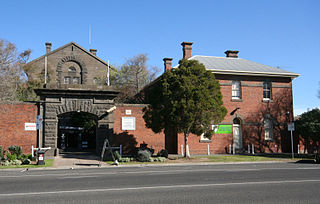
HM Prison Geelong was a maximum security Australia prison located on the corner of Myers Street and Swanston Street in Geelong, Victoria, Australia. The prison was built in stages from 1849 to 1864. Its panopticon design is based on Pentonville Prison in England. The prison was officially closed in 1991 and prisoners were moved to the newly built HM Prison Barwon in Lara. The building now functions as a museum for the history of the prison.

The Old Melbourne Gaol is a former jail and current museum on Russell Street, in Melbourne, Victoria, Australia. It consists of a bluestone building and courtyard, and is located next to the old City Police Watch House and City Courts buildings, and opposite the Russell Street Police Headquarters. It was first constructed starting in 1839, and during its operation as a prison between 1845 and 1924, it held and executed some of Australia's most notorious criminals, including bushranger Ned Kelly and serial killer Frederick Bailey Deeming. In total, 133 people were executed by hanging. Though it was used briefly during World War II, it formally ceased operating as a prison in 1924; with parts of the jail being incorporated into the RMIT University, and the rest becoming a museum.

Risdon Prison Complex is an Australian medium to maximum security prison for males located in Risdon Vale near Hobart, Tasmania. The facility is operated by the Tasmanian Prison Service, an agency of the Department of Justice of the Government of Tasmania. The facility accepts criminals convicted under Tasmanian and/or Commonwealth legislation.
Hayes Prison Farm, a former Australian minimum security prison for males, was established on land at Hayes, near New Norfolk, Tasmania. The facility was operated by the Tasmanian Prison Service, an agency of the Department of Justice of the Government of Tasmania. Located on 800 hectares, the facility accepted felons convicted under Tasmanian and/or Commonwealth legislation. The facility was closed in late 2012.
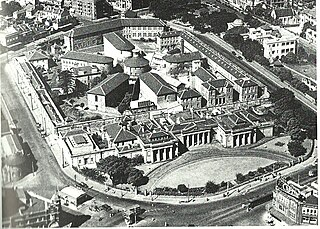
The Darlinghurst Gaol is a former Australian prison located in Darlinghurst, New South Wales. The site is bordered by Darlinghurst Road, Burton and Forbes streets, with entrances on Forbes and Burton Streets. The heritage-listed building, predominantly designed by New South Wales Colonial Architect Mortimer Lewis, was closed in 1914 and has subsequently been repurposed to house the National Art School.
Launceston Reception Centre, formerly the Launceston Remand Centre, an Australian maximum security prison for male and female inmates held on remand, is located in Launceston, Tasmania. The facility is operated by the Tasmanian Prison Service, an agency of the Department of Justice of the Government of Tasmania. The facility accepts felons charged under Tasmanian and/or Commonwealth legislation pending legal proceedings; and also detains convicted felons, pending their classification and placement at other correctional facilities in Tasmania.

The Maitland Gaol, also known as Maitland Correctional Centre, is a heritage-listed former Australian prison located in East Maitland, New South Wales. Its construction was started in 1844 and prisoners first entered the gaol in 1848. By the time of its closure, on 31 January 1998, it had become the longest continuously-run gaol in Australia. It has since been turned into a museum and is a popular tourist attraction. It was added to the New South Wales State Heritage Register on 2 April 1999.

Thomas Jeffrey was a convict bushranger, murderer and cannibal in the mid-1820s in Van Diemen's Land. In contemporary newspaper reports of his crimes he was frequently described as a 'monster'. Jeffrey and three other convicts absconded from custody in Launceston in December 1825 and were subsequently responsible for five murders, characterised by extreme violence, including the killing of a five-month-old infant. Another victim was a member of the gang, killed while he slept and his flesh consumed by his companions. Jeffrey was captured in January 1826; he was tried in Hobart and convicted of various of his crimes. Jeffrey was executed by hanging at Hobart in May 1826.
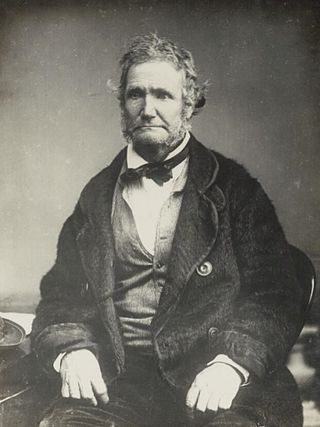
Martin Cash was a notorious Irish-Australian convict bushranger, known for escaping twice from Port Arthur, Van Diemen's Land. His 1870 autobiography, The Adventures of Martin Cash, ghostwritten by James Lester Burke, also a former convict, became a best seller in Australia.
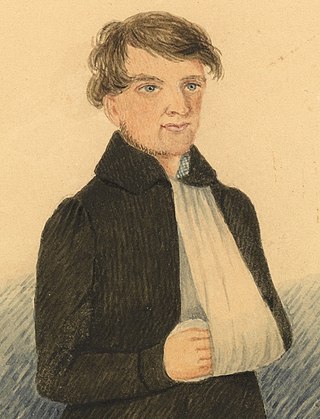
Lawrence Kavenagh was an Irish-Australian convict bushranger who, with Martin Cash and George Jones, escaped from Port Arthur, Van Diemen's Land, in late 1842. The three men took to bushranging for a six-month period, robbing homesteads and inns with seeming impunity. Kavenagh was tried for serious crimes on five separate occasions. He was executed in 1846 at Norfolk Island.
The modern history of the Australian city of Hobart in Tasmania dates to its foundation as a British colony in 1804. Prior to British settlement, the area had been occupied for at least 8,000 years, but possibly for as long as 35,000 years, by the semi-nomadic Mouheneener tribe, a sub-group of the Nuenonne, or South-East tribe. The descendants of the indigenous Tasmanians now refer to themselves as 'Palawa'.

The Perth Gaol was a gaol built in Perth, the state capital of Western Australia, between 1854 and 1856 to house convicts and other prisoners. It is located just west of Beaufort Street.

The Richmond Gaol is a convict era building and tourist attraction in Richmond, Tasmania, and is the oldest intact gaol in Australia. Building of the gaol commenced in 1825, and predates the establishment of the penal colony at Port Arthur in 1833. One of the tasks completed by the convicts who were held at Richmond Gaol was the construction of Richmond Bridge.
John Lee Archer was the Civil Engineer and Colonial Architect in Van Diemen's Land, serving from 1827 to 1838. During his tenure, Archer was responsible for all Tasmanian government buildings including those for penal and military purposes.

St John's Anglican Church is an Anglican church located in New Town, Tasmania, Australia, is notable for its unbroken record of use as a parish church, from the first service on 20 December 1835 up to the present. The parish is administered by the Anglican Diocese of Tasmania.
Brisbane Street is a street in Hobart, Tasmania. The street was named for Sir Thomas Makdougall Brisbane, the sixth Governor of New South Wales.
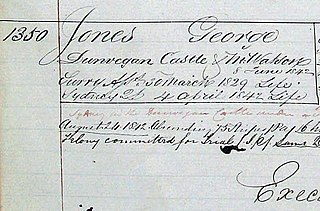
George Jones (c. 1815 – 30 April 1844) was a convict bushranger who, with Martin Cash and Lawrence Kavenagh, escaped from Port Arthur, Van Diemen's Land, in late 1842. The three men took to bushranging for a six-month period, robbing homesteads and inns with seeming impunity. After Kavenagh and Cash were captured, Jones remained at large for a further seven months, committing a number of robberies in company with two other escaped convicts. In April 1844 he was captured in a shoot-out with police, convicted and executed.
Crime in Tasmania has existed since the earliest days of the European settlement in 1803. Laws creating criminal offences are contained entirely in statutes, statutory regulations, and by-laws, common law offences having been abolished by the Criminal Code Act 1924 s 6. Most offences are enforced by Tasmania Police, although a small category of offences are prosecuted by other statutory authorities such as local governments, and the Tasmanian branch of RSPCA Australia. All offences are prosecuted through the Tasmanian justice system, and sentences of imprisonment are administered by the Tasmania Prison Service. Some crime statistics for Tasmania are provided on the Tasmania Police website.

















